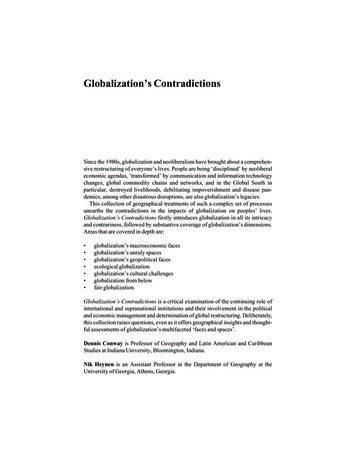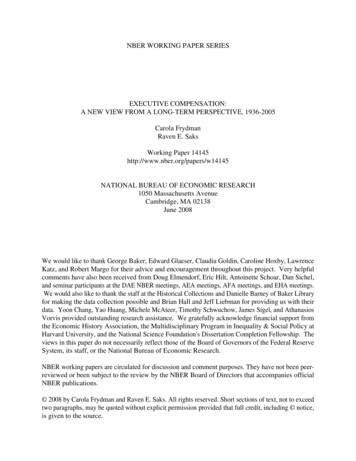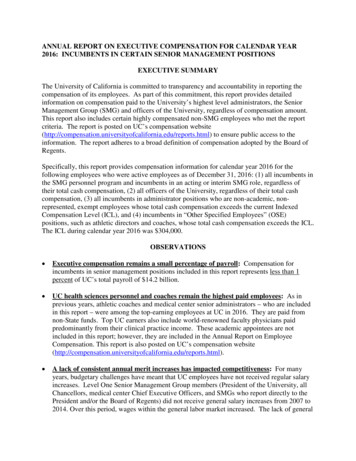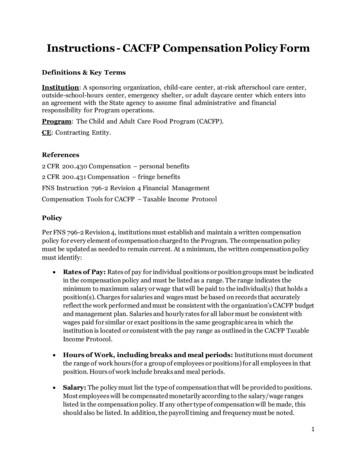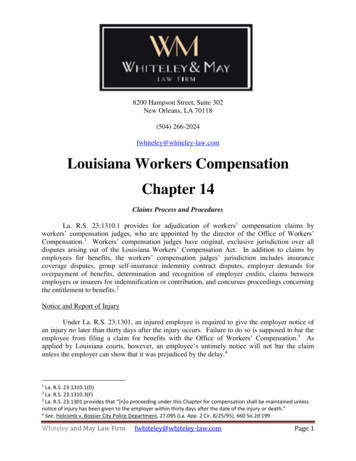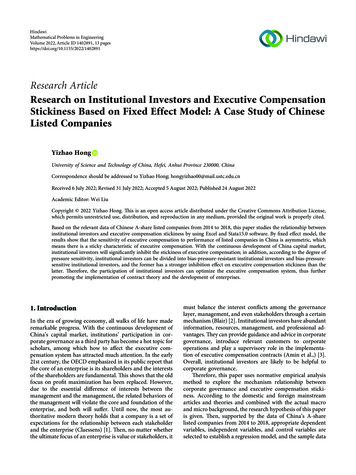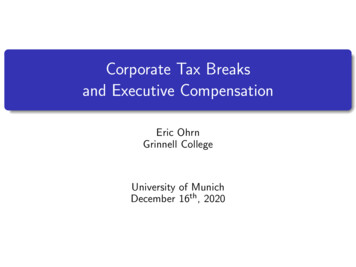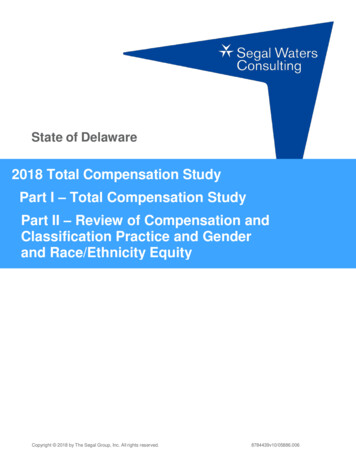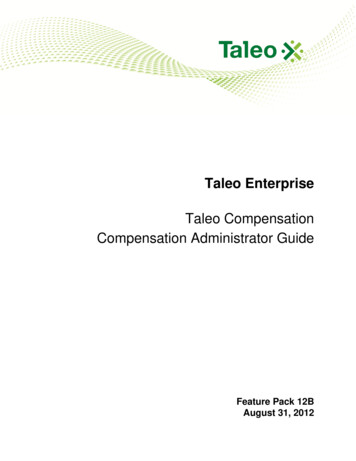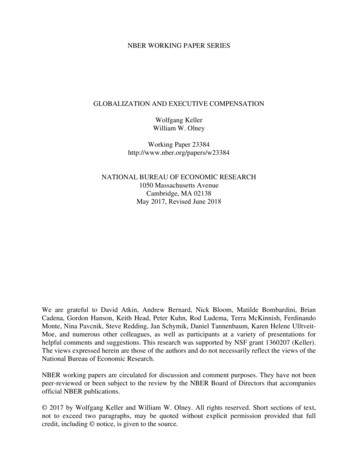
Transcription
NBER WORKING PAPER SERIESGLOBALIZATION AND EXECUTIVE COMPENSATIONWolfgang KellerWilliam W. OlneyWorking Paper 23384http://www.nber.org/papers/w23384NATIONAL BUREAU OF ECONOMIC RESEARCH1050 Massachusetts AvenueCambridge, MA 02138May 2017, Revised June 2018We are grateful to David Atkin, Andrew Bernard, Nick Bloom, Matilde Bombardini, BrianCadena, Gordon Hanson, Keith Head, Peter Kuhn, Rod Ludema, Terra McKinnish, FerdinandoMonte, Nina Pavcnik, Steve Redding, Jan Schymik, Daniel Tannenbaum, Karen Helene UlltveitMoe, and numerous other colleagues, as well as participants at a variety of presentations forhelpful comments and suggestions. This research was supported by NSF grant 1360207 (Keller).The views expressed herein are those of the authors and do not necessarily reflect the views of theNational Bureau of Economic Research.NBER working papers are circulated for discussion and comment purposes. They have not beenpeer-reviewed or been subject to the review by the NBER Board of Directors that accompaniesofficial NBER publications. 2017 by Wolfgang Keller and William W. Olney. All rights reserved. Short sections of text,not to exceed two paragraphs, may be quoted without explicit permission provided that fullcredit, including notice, is given to the source.
Globalization and Executive CompensationWolfgang Keller and William W. OlneyNBER Working Paper No. 23384May 2017, Revised June 2018JEL No. F14,J3ABSTRACTThis paper finds that globalization is contributing to the rapid increase in executive compensationover the last few decades. Employing comprehensive data on top executives at major U.S.companies, we show that their compensation is increasing with exports and foreign directinvestment, as well as firm size and technology. Exogenous export shocks unrelated tomanagerial decisions also increase executive compensation, and there is little evidence that this isdue to increasing market returns to talent. We do find that export shocks primarily affectdiscretionary forms of compensation of more powerful executives at firms with poor corporategovernance, as one would expect if globalization has enhanced rent-capture opportunities.Overall, these results indicate that globalization has played a more central role in the rapid growthof executive compensation and U.S. inequality than previously thought.Wolfgang KellerDepartment of EconomicsUniversity of Colorado, BoulderBoulder, CO 80309-0256and NBERWolfgang.Keller@colorado.eduWilliam W. OlneyDepartment of EconomicsWilliams CollegeWilliamstown, MA 01267william.olney@williams.edu
1Introduction“American policy has allowed the winners to keep most of the spoils of trade and has given the loserscrumbs. This has exacerbated income inequality by raising the profits of big corporations and the salaries ofexecutives and other white collar professionals while leaving blue-collar and lower-skilled workers poorer”New York Times Editorial April 2, 2016Globalization and income inequality are currently two of the most important economic issues, withdissatisfaction about both shaping elections throughout the world. While there is a common perceptionthat these issues are related (as illustrated by the quote above), research has tended to focus on the impactof globalization on blue-collar workers. However, it is high incomes, especially the top 1%, that appear todrive U.S. inequality, as Figure 1 shows:1FIGURE 1% of Total Income Accruing to Each Group5101520U.S. Income SharesTop 1%50s Decile010s Decile1978198419901996Year200220082014Notes: Kernel-weighted local polynomial smoothed data from World Wealth andIncome Database (WID; website: wid.world).This paper examines the relationship between globalization and growing inequality by focusing on theincomes of top business executives. By 2013, the typical top business executive of a Standard and Poor 500Indexed firm earned 3.7 million a year, while Chief Executive Officers (CEOs) made 7.5 million a year,1We also show the evolution of all U.S. income deciles in Appendix A.1.2
putting both safely within the top 1% of all income earners.2 Moreover, non-finance business executivesare by far the largest share of the top 1% and are representative of the top 1% more generally (Bakija,Cole, and Heim 2012, Kaplan and Rauh 2013). Furthermore, executive compensation is rising relativelyquickly, with CEO pay increasing more than eight times as fast as average worker pay over the last threeand half decades (Edmans, Gabaix, and Jenter 2017). We study business executives, but compensation inother fields like entertainment and sports may be even more susceptible to globalization.3While the income trends of Figure 1 are well-documented and exist in most high-income countries,the causes of this growth in inequality have remained controversial.4 A variety of explanations have beenproposed, but globalization has rarely been a focus (e.g. Bertrand 2009). Thus, our first goal is to examinewhether globalization is contributing to the rapid increase in top incomes. Figure 2 shows that overthe last seventy years there has been a rapid increase in both executive compensation and exports (wewill also analyze foreign direct investment and imports). While gross domestic product (GDP) is alsotrending upwards, executive compensation is more closely associated with exports. This does not implycausality, but it does suggest that the question of whether globalization has contributed to rising executivecompensation is potentially important.2The threshold depends to some extent on whether measures of total income or labor income are employed; Guvenenand Kaplan (2017) discuss a number of major issues. Piketty, Saez, and Zucman (2017) note that 1.3 million is the averagepre-tax income of the top 1% in 2014, with the cutoff lower than that. Guvenen, Kaplan, and Song (2014) show that the 1%wage and salary threshold in 2012 was 291,000 based on a 10% sample of Social Security Administration data, with wagesand salaries accounting for about 60% of total income for the top 1% individuals.3Entertainment and sports superstars have benefited from the ability to reach large global audiences (e.g. Gordon andDew-Becker 2008).4Appendix A.2 shows that the share of income going to the top 1% is increasing in most OECD countries. Gordon andDew-Becker (2008) and Edmans, Gabaix, and Jenter (2017) examine why the trend is quantitatively stronger in the US.3
FIGURE 21500Execu CompGDP5001000Exports (2009 b), GDP (2009, 10b)Median Executive Compensation (2000 k)10002000300040005000Executive Compensation and Exports in Long Run0Exports19361946195619661976198619962006Notes: Data on the median compensation of the three highest paid executives at the50 largest U.S. firms comes from Frydman and Saks (2010). Total compensationincludes salary, bonuses, stocks, and options granted (valued using Black –Scholes). Real U.S. GDP and export data comes from FRED (St. Louis Fed)To the extent that globalization matters for executive compensation, our second goal is to understandwhy it increases executive pay. First, perhaps market forces reward talented executives who make strategicdecisions that expand their firm abroad. Such executives earn more because they successfully navigatethe logistics of selling to many markets, deal with the complexity of setting up production stages thatspan numerous countries, and overcome bargaining and contractual issues in foreign countries. In thiscase, globalization’s effect on pay is the result of the executive’s talent and actions. Pay increases can alsobe due to market forces outside the executive’s control that increase the importance of top talent. Forinstance, globalization can increase optimal firm size (Melitz 2003), and it may induce the reassignment ofthe most talented managers to the strongest firms (Gabaix and Landier 2008, Terviö 2008). Globalizationmay also increase pay because it generates new competition for managerial talent (Marin and Verdier2012) or because it changes the firm’s organizational structure (Rajan and Wulf 2006, Caliendo, Monte,and Rossi-Hansberg 2015). In short, globalization may alter the nature of the executive’s job, increase theimportance of top talent, and thus lead to higher pay (see Rosen 1981).5 We will refer to these componentsof increasing executive pay as market returns.5In addition, there is evidence that executives now have better outside options because they are increasingly externallyrecruited and have general, not firm-specific, skills (Murphy and Zabojnik 2006, Frydman 2016).4
Second, globalization can increase executive pay through non-market channels. In particular, rentcapture is an important determinant of executive pay (Bertrand and Mullainathan 2001, Bebchuk and Fried2004, Bivens and Mishel 2013) and we investigate if globalization facilitates these activities. The sheer sizeof global firms alone might enhance rent-capture opportunities, or international transactions might makeit harder for shareholders, board members, as well as regulatory and tax authorities to monitor executives.Globalization induced rent-capture activities may be more feasible for certain types of pay, executives,and firms. By intensifying competition for talent, globalization may also make very high salaries moreacceptable by shifting social norms (Piketty and Saez 2003, 2006), which facilitates future rent-capture.Higher levels of competition may also encourage bench-marking executive pay to a relevant peer group,which has been found to inflate corporate pay (Bizjack, Lemmon, and Nguyen 2011). We will refer to thesepay increases as non-market returns.Distinguishing between market and non-market returns is important because it influences society’swillingness to tolerate inequality. If pay reflects market forces that optimally reward the executive’s talentand actions, inequality will be less objectionable than if executive pay increases due to rent-capture. Inaddition to the immediate distributional implications, executive compensation has been a controversialtopic with broader ramifications (see Bertrand 2009, Edmans, Gabaix, and Jenter 2017). Rising executivepay, especially due to rent-capture, can lead to polarization and undermine social cohesion.6The relationship between globalization and top incomes is studied by examining the impact of exports,imports, and foreign direct investment (FDI) on the compensation of executives over the years 1993 to2013. Our analysis focuses on top executives at publicly traded U.S. firms from Compustat’s comprehensiveand well-known ExecuComp data set. We examine whether globalization is influencing top incomes, andif so whether this relationship reflects market or non-market returns.In line with the simple correlation in Figure 2 our first finding is that firm-specific exports, identifiedusing detailed product level trade and firm sales data, have a significant positive impact on executivecompensation. An important contribution of our paper is that while firm size and technology investmentsraise executive compensation, exports increase pay conditional on these and other firm characteristics.7 Inaddition, a portion of export’s impact on executive pay operates through size and technology, indicatingthat globalization affects pay through these market channels. Quantitatively, we find that the magnitude6On the impact of globalization on economic polarization, see Keller and Utar (2016). On the link between globalizationand political polarization, see Autor, Dorn, Hanson, and Majlesi (2016), Dippel, Gold, Heblich, and Pinto (2017), and Che,Lu, Pierce, Schott, and Tao (2017) .7We also condition on a variety of other firm and industry characteristics, such as insider board relationships, markups, andvalue added. We also explore whether top marginal tax rates influence executive compensation (Piketty, Saez, and Stantcheva2014) although the available data is more limited.5
of export’s impact on executive compensation is comparable to that of firm size and technology. Resultsalso show that exports increase executive pay more than average worker wages, and that compensationincreases more with foreign affiliate sales than with domestic sales. Overall, these results indicate thatglobalization has been a more important force behind the increase in executive compensation and inequalitythan generally perceived.Second, we examine why globalization is increasing executive compensation. We employ a Bartik (1991)style shift-share instrument that identifies exogenous export shocks which are by construction independentof the executive’s actions.8 The results indicate that a 10% exogenous export shock leads to a 3% increasein the compensation of executives.9 Using a back-of-the-envelope calculation this estimate indicates thatexports can account for about a third of the observed increase in executive compensation over this period.10Even though export shocks are not caused by managerial decisions they can nevertheless alter marketcharacteristics which in turn increase executive pay. For instance, a positive shock may encourage firmsto match with a better, more highly paid executive, or it may drive up the returns to talent by changingthe nature of the manager’s job. Consistent with assortative matching, we find that export shocks leadto more executive turnover and higher pay for newly hired executives, however the magnitudes of theseeffects are small. Furthermore, we find no evidence that export shocks lead to higher returns to moreskilled executives.11Lacking strong evidence for a market returns explanation, we turn to the non-market explanation ofrent-capture. Evidence of asymmetry, where executive compensation increases with positive shocks butdoes not decrease with negative shocks, suggests that it might be important. We go further by firstexploiting the fact that some forms of compensation are set in a more discretionary way than others, andthus are more susceptible to rent-capture. Export shocks are found to strongly increase bonus payments,with little impact on less-discretionary forms of compensation like salary.12 Second, we exploit the fact8Our instrument is constructed using presample industry-level bilateral export flows and exogenous industry-level exportgrowth in other high-income countries. Examples of instrumental variables strategies based on other countries include Haskel,Pereira, and Slaughter (2007), Autor, Dorn, and Hanson (2013), and Blanchard and Olney (2017). Similar results are obtainedusing alternate instrument variable strategies based on world import demand and exchange rate fluctuations.9An added benefit of focusing on globalization is that it is easier to identify exogenous shocks that are unrelated to domesticconditions. We suspect that domestic shocks may also influence executive compensation but it is more challenging to identifythese empirically.10Multiplying export growth (168%) and our point estimate (0.300), implies exports increased TDC1 by 50% from 1993 to2013. This represents about a third of the observed increase in TDC1 (141%) over this period.11Related to this analysis is the concept of relative performance evaluation (RPE; Holmström 1979), which implies thatoptimal contracts should only reward executives for relative performance differences. The lack of RPE is well documented(Gibbons and Murphy 1990 and others). Under certain conditions, e.g. when there are constraints on the feasible set ofcontracts, the optimal contract need not satisfy RPE (see Edmans, Gabaix, and Jenter 2017). We have examined this issueand found little evidence that our results are driven by common explanations for why RPE would not hold (results availableupon request).12In principle, the stock-option innovation of the 1990s may have been important for diverting additional rents to top6
that rent-capture is more likely at poorly governed firms and indeed our results show that the impactof exogenous export shocks is stronger at those firms with insider board relationships. Finally, we takeinto account the fact that some executives have more managerial power to influence pay decisions thanothers. In particular, we show that the effect of export shocks on bonuses is strongest for CEOs of poorlygoverned firms. Together these results indicate that rent-capture associated with globalization has beenan important factor in the rise of executive compensation.We verify that the results are robust to (i) a wide variety of alternate specifications that account for unobserved executive, executive-by-firm, and industry-by-year conditions, (ii) employing alternate measuresof firm size, (iii) addressing possible selection by using different samples, (iv) dealing with the potential endogeneity of poor governance, and (v) examining the role of imports.13 Overall, we show that globalizationhas contributed to the recent rise in top-incomes by increasing executive compensation.The paper makes a number of contributions. First, it speaks to important work assessing the impact ofglobalization on inequality. Early studies concluded that skill-biased technical change may have been moreimportant than globalization in explaining rising inequality (Katz and Autor 1999, Feenstra and Hanson1999). However, this literature tended to focus on the distinction between skilled and unskilled workers,not the role of the top 1% of income earners. More recently there has been a growing consensus that risingimport competition, driven in part by China (Krugman 2008), has adversely affected blue-collar workers(Autor, Dorn, and Hanson 2013, Pierce and Schott 2016). Our analysis complements this work by shiftingthe focus to exports, foreign direct investment, and the gains experienced by high-income earners.14 Thisis important because high-income earners, especially the top 1%, are arguably the most important driversof income inequality (see Figure 1, as well as Piketty and Saez 2003, 2006, Piketty, Saez, and Zucman2017).Second, while anecdotal evidence indicates that globalization is contributing to rising executive compensation, to date it has received little attention from researchers. Globalization is sometimes dismissedas a potential explanation because it should be ubiquitous whereas the trends in top income shares acrosscountries differ (Alvaredo, Atkinson, Piketty, and Saez 2013, Piketty, Saez, and Stantcheva 2014).15 Others argue that globalization should affect occupations differently whereas the trends in top incomes acrossoccupations are the same (Kaplan and Rauh 2013). In contrast, our analysis is based on longitudinal,executives (Bebchuk and Fried 2004, Bertrand 2009); we will explore this dimension of the data in sections 5.2 and A.6.13Imports are found to have an insignificant impact on executive compensation (see Appendix A.7).14Hummels, Jorgensen, Munch, and Xiang (2014) study the impact of exports on wages, although they do not focus on topincomes.15While there is certainly variation in top income growth rates across countries, Figure A2 shows a clear upward trendacross a diverse set of OECD countries (see Appendix A.2).7
micro-level data that addresses many potential sources of spurious results. Globalization is a promisinglong-run explanation for the changing pattern of executive pay over the last century. Any successful explanation needs to deal with why executive pay was relatively flat prior to 1980 and has increased dramaticallythereafter (recall Figure 2). Insider board relationships is a prominent explanation for rising executive pay(Bertrand and Mullainathan 2001), however by most measures corporate governance has strengthened,not weakened, since 1980.16 Growth in firm size is another common explanation for the recent increasein executive compensation (Gabaix and Landier 2008). However, firm size also increased from the 1940sto the early 1970s when CEO compensation was virtually flat (Frydman and Saks 2010). In contrast,globalization provides a compelling explanation for the evolution of executive compensation because thetime series variation in exports and executive compensation track each other closely before and after 1980(see Figure 2).Third, we provide a unifying analysis of the executives’ market and non-market returns, which aretoo often treated as mutually exclusive explanations. Our findings show that executive compensation isincreasing with market forces such as firm size and technology investments, consistent with Gabaix andLandier (2008) and Garicano and Rossi-Hansberg (2006), respectively. A portion of globalization’s impacton executive pay operates through size and technology, while another portion affects pay after holding sizeand technology constant, a finding that is new to the literature.17 We find that executive pay increaseswith shocks unrelated to executive action, as in Bertrand and Mullainathan (2001), and that marketreturns explain only a small part of the observed relationship between export shocks and compensation.Furthermore, evidence showing that positive shocks increase executive pay but negative shocks do notdecrease pay point to rent-capture.18 We confirm this by showing that export shocks disproportionatelyincrease discretionary pay to powerful managers at poorly governed firms. Overall, our findings show thatboth market and non-market forces are important in explaining the rapid rise in executive compensation.The paper proceeds as follows. In the next section, we discuss the data sources employed in thisanalysis, provide background information on executive compensation, and describe the main relationshipbetween executive pay and exports. Section 3 tackles our first key question of whether globalization is16For example, due to possible conflicts of interest the Security and Exchange Commission (SEC) started requiring firms in2006 to disclose the role and identity of all paid compensation consultants, and in 2010 the Dodd-Frank Act strengthened thisto stipulate that only independent consultants can be hired. Indeed, Chhaochharia and Grinstein (2009) find strong decreasesin CEO compensation at firms affected by Sarbanes-Oxley-inspired legislation which required that the majority of a board’sdirectors be independent. In fact, some argue that higher executive pay should be viewed as compensation for the hassle ofincreased regulatory requirements (Hermalin 2005). See Murphy and Zabojnik (2004) and Edmans, Gabaix, and Jenter (2017)for more discussion.17For instance, Ma (2015) finds no relationship between exports and executive pay once firm size is accounted for.18See also Bertrand and Mullainathan (2001) and Garvey and Milbourn (2006) on this asymmetry.8
contributing to the rapid increase in executive pay. Confirming this to be the case, we then proceed toour second question: why is this occurring? Specifically, in Section 4 we find that export shocks that areorthogonal to executive actions and other domestic conditions nonetheless increase executive compensation.Furthermore, the evidence that these export shocks increase market returns through assortative matchingor through increasing returns to talent is weak. We turn our attention to rent-capture in Section 5, findingthat export shocks increase discretionary pay to powerful managers at poor governance firms. We explore avariety of extensions in both Section 6 and in the Appendix, which shed additional light on the relationshipbetween globalization and executive pay as well as demonstrates that the results are robust to alternatespecifications and samples.2DataThe empirical analysis utilizes executive compensation data, firm and executive level information, andglobalization data from the following sources.2.1Executive CompensationCompensation information of the top five executives within each Standard & Poor (S&P) firm was obtainedfrom the Compustat ExecuComp data set. This is the most comprehensive publicly available data set onexecutive compensation, with information about each executive, including their name and identifier as wellas their company’s name and identifier. Importantly, the data set has detailed administrative compensationinformation based on company filings with the U.S. Securities and Exchange Commission (SEC).Our measure of executive compensation is ExecuComp’s TDC1, which includes total compensationawarded to an executive in a given year. An alternative measure, TDC2, captures compensation realizedby an executive in a given year. Globalization may have a different impact on compensation realized andcompensation awarded, given that the executive has more influence over the former than the latter. Byemploying the TDC1 measure we eliminate the possibility that executives strategically exercise their stockoptions in response to positive shocks.19An appealing feature of this executive compensation data is that it also provides detailed informationon individual components of compensation, allowing us to examine how globalization affects more andless discretionary types of pay. The five components of executive pay are salary, bonuses, stock optionsawarded, stock awards, and other compensation. Salary is the executive’s base salary while bonuses includes19The results in Table A8 confirm this by showing that export shocks have a larger impact on TDC2 than TDC1.9
bonuses and long-term non-equity incentive plans. Options give the value of stock options awarded, stocksare the value of restricted stock granted, and other compensation includes personal benefits, 401k plans,life insurance premiums, termination payments, and tax reimbursements, among other components. Notethat all nominal compensation values are converted to constant 2014 U.S. dollars using the Consumer PriceIndex (CPI) provided by the Bureau of Labor Statistics.On average in 2013, a top five executive in our sample earned 3.7 million which consisted of about 0.6m of salary, 0.8m of bonuses, 0.6m of options, 1.4m of stocks, and 0.2m of other compensation(in 2014 dollars). By comparison, CEOs earned 7.5m overall which consisted of 1.0m of salary, 1.7mof bonuses, 1.5m of options, 3.0m of stocks, and 0.4m of other compensation. Our subsequent analysiswill exploit the fact that export shocks may affect these components of executive pay differentially.The relative importance of these forms of compensation over time is presented on the left hand sideof Figure 3.20 Consistent with other findings, this figure shows that options represented a larger share ofcompensation in the late 1990s, while stocks represent a larger share of pay more recently (see Frydman andJenter 2010, and Edmans, Gabaix, and Jenter 2017 for additional details). The growth in the importance ofstock options since the 1970s is often emphasized, however cash remunerations such as salary and bonuseshave been factors as well (Bertrand 2009).FIGURE 3Executive Compensation Components by Firm Type00Execu Comp Components (%)20406080Execu Comp Components (%)20406080100100Executive Compensation Components by YearS&P 5001993 1995 1997 1999 2001 2003 2005 2007 2009 2011 usesSmallCapOptionsStocksOtherOtherNotes: Salary includes the executive's base salary, Bonuses includes bonuses and long-term non-equity incentive plans, Options are the value of stockoptions awarded, Stocks are the value of restricted stock granted, and Other is all other compensation received by the executive. Source: ExecuCompThe right hand side of Figure 3 examines the composition of pay across different firm types. Followingcommon distinctions in the literature, we focus on S&P 500 firms, S&P MidCap firms, S&P SmallCap firms,20The SEC changed its reporting rules in 2006 and our analysis takes into account these definitional changes.10
and Other firms. We find that salary, for instance, represents a somewhat lower share of compensation atS&P 500 firms (13%) and a higher share at SmallCap firms (28%) on average in our sample. In contrast,bonuses are fairly consistent across firm type at around 20% of total compensation. While there are somedifferences, overall the composition of compensation is similar across firm type, which is line with otherevidence (see Edmans, Gabaix, and Jenter 2017). Appendix A.5 shows that our results are similar acrossdifferent samples of firms.2.2GlobalizationOur main measure of globalization is international trade, given its excellent coverage and the fact thatit is often correlated with other forms of globalization. Detailed U.S. export and import data at theHarmonized System (HS) ten-digit product level for the years 1989-2012 come from the U.S. Census Bureauvia Schott’s International Economics Resource Page (Schott 2008), since Compustat does not report firmexports. These nominal trade flows are converted to constant 2014 U.S. dollars using the consumer priceindex (CPI). An appealing aspect of this data set is that the HS ten-digit trade flows are linked to thesix-digit industry codes of the North American Industry Classification System (NAICS). This enables usto merge this trade data with the ExecuComp data which reports the six-digit NAICS industries of theexecutive’s firm. Furthermore, this data set reports detailed product level trade at the bilateral level (U.S.flows to any particular foreign country), which is used in our instrumental variable analysis. While ourprimary interest lies in how access to foreign markets via exports affect executive compensation, we alsocover the role of imports and foreign direct investment in our analysis.A firm-specific measure of exports is constructed as the weighted average of detailed product-levelexports, where the weights are the share of sales of the firm’s three largest business segments.21 Accountingfor the fact that many firms in our data set operate in several industries improves our ability to measureexports and its impact on executive pay.22 Since the industry in which the firm operates may evolveendogenously over time, we focus on the firm’s composition of sales in the presample
of executive compensation and U.S. inequality than previously thought. Wolfgang Keller Department of Economics University of Colorado, Boulder Boulder, CO 80309-0256 . Income Database (WID; website: wid.world). Top 1% 50s Decile 10s Decile 0 5 10 15 20 % of Total Income Accruing to Each Group 1978 1984 1990 1996 2002 2008 2014
